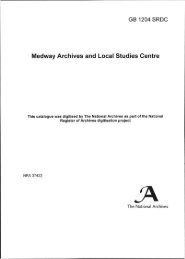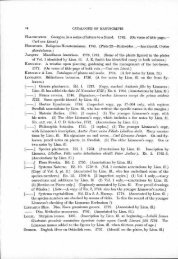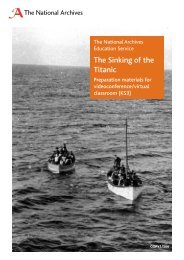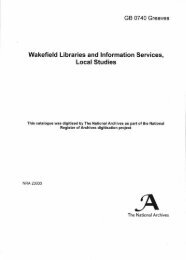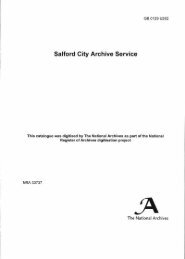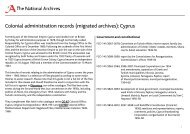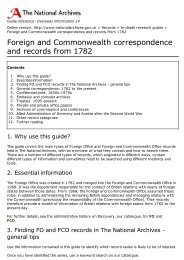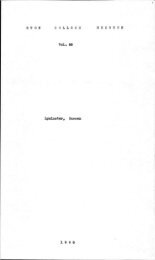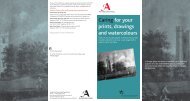link to scanned list part 1 - The National Archives
link to scanned list part 1 - The National Archives
link to scanned list part 1 - The National Archives
Create successful ePaper yourself
Turn your PDF publications into a flip-book with our unique Google optimized e-Paper software.
Sir John Hawkins<br />
HISTORICAL INTRODUCTION<br />
CH.108<br />
Hawkins was born in Plymouth, Devon in 1532, the younger son of William Hawkins, an<br />
experienced naviga<strong>to</strong>r and merchant known <strong>to</strong> Richard Hakluyt.<br />
William Hawkins was also a prominent citizen of Plymouth where he served as Mayor 1532-1533<br />
and 1538-1539 and which he represented in Parliament in 1539. John Hawkins' elder brother<br />
William was also Mayor of Plymouth 1578-1579.<br />
John Hawkins was therefore brought up in an established seafaring and mercantile family and may<br />
also have gained military skills with his father privateering in the English Channel. After his own<br />
voyages <strong>to</strong> the Canaries, Teneriffe, Guinea in West Africa and Portugal, Hawkins looked more<br />
ambitiously <strong>to</strong>wards the West Indies. <strong>The</strong>reafter, Hawkins alternately clashed or traded with the<br />
Spanish Empire.<br />
Hawkins' civil career <strong>to</strong>ok after his family's example. In 1556 Hawkins was admitted Freeman of<br />
Plymouth and he served as Mayor in 1572.<br />
<strong>The</strong> Hawkins family coat of arms, augmented by Sir John in 1564, is depicted on an estate plan in<br />
the collection (/276A). Interpretation of the inspiration for the crest on the coat of arms varies,<br />
although it certainly stems from Hawkins' own voyages.<br />
Arnold describes the crest as comprising a "demi-moor proper, bound captive, with annulets on his<br />
arms and in his ears", attributing this <strong>to</strong> Hawkins commemorating a vic<strong>to</strong>ry over the Moors<br />
achieved on one of his voyages (p. 19). Arnold, a Solici<strong>to</strong>r and responsible figure in the Medway<br />
Towns, was clerk <strong>to</strong> numerous organisations and Deputy Governor of Hawkins' Hospital.<br />
Writing earlier than Arnold and for a more popular readership, Harris describes the crest as a<br />
"demi-moor in his proper colour bound with cord" and attributes this <strong>to</strong> Hawkins' "infamous<br />
traffic in slaves, which at that period does not seem <strong>to</strong> have militated against the feelings of the<br />
most enlightened and humane of our countrymen" (p.7).<br />
It is conceivable that at this time physical conditions for enslaved negroes had not yet degenerated<br />
<strong>to</strong> those of the Eighteenth Century. On Hawkins' second slaving voyage, planned in 1564, 120<br />
quarters of beans and peas with shirts and shoes were loaded for the anticipated 500 captives<br />
(Williamson 1927/p.95).<br />
Through Hawkins' contact with Benjamin Gonson, Treasurer of the Navy (and a financial backer<br />
of his second slaving voyage), he was introduced <strong>to</strong> Gonson's daughter Katherine whom he<br />
married in about 1559. This relationship with Gonson also resulted in Hawkins inheriting on<br />
1st January 1578 the office of Treasurer of the Navy, following this with the Comptrollership of<br />
the Navy in 1588, the Armada year. (A B. Gonson is mentioned in /349).<br />
It was during Hawkins' period in office as Treasurer that he established the <strong>link</strong> with Chatham<br />
which was <strong>to</strong> result in the foundation of the Chatham Chest and Hawkins' Hospital, both of which<br />
followed in the wake of the Spanish Armada.<br />
In the period 1578-1588 Hawkins' time as Treasurer saw new influences in the design of warships<br />
and in the administration of the navy, with both of which Hawkins has been associated. As Rear<br />
Admiral serving in the English Channel against the Spanish Armada, Hawkins distinguished<br />
himself in an engagement off the Isle of Wight, following which Hawkins was knighted by Lord<br />
Howard of Effingham on board the Arc on 25th July 1588 and was advanced Vice Admiral the<br />
following day.<br />
After a period ashore during which Hawkins was closely involved in the founding of the Chatham<br />
Chest (1588-1590) and his Hospital (1592-1594), he again <strong>to</strong>ok <strong>to</strong> sea, in an expedition <strong>to</strong> the West<br />
Indies led by Sir Francis Drake. Falling ill and dying off Por<strong>to</strong> Rico on 12th November 1595, his<br />
p d 5/env/john-haw.sd(nf/msm)




